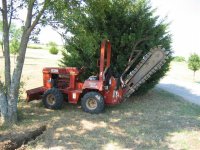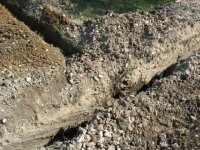</font><font color="blue" class="small">( Gary, I guess I don't quite understand what you are saying about the open discharge. My well produces about 35 GPM I am told, but the pump is only pumping out 25 GPM, so it would seem to me that it would run indefinitely, in fact I have done so for 72 hours straight when the well was first dug, trying to clear it up.
If I run 1.5 inch out to the pond and put a regular 3/4 bib right there, I wonder what kind of GPM I could pump through that regular bib? If I can do 20 or 25 GPM through only about 36" of 3/4 and out the bib, then I won't need the large discharge.
I don't expect to fill the pond by pumping water into it but would hope to mitigate the evaporation somewhat. )</font>
A well recovers at a certain gpm, meaning water runs into it at that rate. The water level comes up to match the height of the water table (static water) level outside the well and the recovery flow stops. Let's say that the static water level is 30' below the yard.
Drop a pump in the water to 300' and turn it on, the water level in the well falls from 30' at the rate the pump DELIVERS water minus the recovery rate; which will lag a bit. If you kept pumping until the level stops falling, that is the pumping level of the well; out take equals in put. Now as the water level falls, the pump works harder because actually, the pump only has to move water from the water level in the well and now there's a lower level of water in the well, say its down to 100'. The pump is moving water from there, not the pump's depth. Recall that the pump rating of 25 gpm is from the depth on the chart, not really, it's total dynamic 'head' actually but play along... so the pump delivers a lot more water from the water level depth in the well than 25 gpm from the 300' depth on the chart. That's a fair representation without getting deep into the technical.
Some of the technical. That 300' depth is based on the total 'head' (stated in head feet) including the pressure you want to operate the system at, say 30/50 psi. It also includes pressure loss due to friction in the tubing and all fittings and elevation to the highest fixture to be served. Now I lift the pump drop pipe up out of the well 2' by disconnecting the pitless adapter, and turn on the pump. The water flows from an open pipe, that's open discharge... The pump is only moving water from the static water level in the well to the top of the drop pipe. I have no more friction or fitting loses or elevation related to the house and plumbing and the pump hums right along, delivering a lot more gpm than it will if I hook it back up to the house plumbing system by reconnecting the pitless adapter in the well.
And once a pump motor is started, it costs next to nothing to keep it running when compared to the start up amp draw which spins electric meters; that's also where most pump wear occurs. So in this case of moving water 350' was it to a pond from a well, the size of the pipe doesn't matter as long as it is not too much smaller than the outlet of the pump bieng used. Most pumps are 1.25" and dropping back to 1" is not a problem and rarely effects the gpm delivered on the chart because you're only pumping from the static water level in the well and have no restriction with open discharge. And that open discharge can be a problem and you may need a throttle back valve, any partially closed valve or pipe restriction to provide some back pressure against the pump.
Gary Slusser


